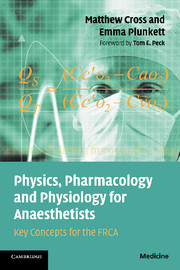Book contents
- Frontmatter
- Contents
- Acknowledgements
- Preface
- Foreword
- Introduction
- Section 1 Mathematical principles
- Section 2 Physical principles
- Simple mechanics
- The gas laws
- Laminar flow
- Turbulent flow
- Bernoulli, Venturi and Coanda
- Heat and temperature
- Humidity
- Latent heat
- Isotherms
- Solubility and diffusion
- Osmosis and colligative properties
- Resistors and resistance
- Capacitors and capacitance
- Inductors and inductance
- Defibrillators
- Resonance and damping
- Pulse oximetry
- Capnography
- Absorption of carbon dioxide
- Cardiac output measurement
- The Doppler effect
- Neuromuscular blockade monitoring
- Surgical diathermy
- Cleaning, disinfection and sterilization
- Section 3 Pharmacological principles
- Section 4 Pharmacodynamics
- Section 5 Pharmacokinetics
- Section 6 Respiratory physiology
- Section 7 Cardiovascular physiology
- Section 8 Renal physiology
- Section 9 Neurophysiology
- Section 10 Statistical principles
- Appendix
- Index
Osmosis and colligative properties
Published online by Cambridge University Press: 15 January 2010
- Frontmatter
- Contents
- Acknowledgements
- Preface
- Foreword
- Introduction
- Section 1 Mathematical principles
- Section 2 Physical principles
- Simple mechanics
- The gas laws
- Laminar flow
- Turbulent flow
- Bernoulli, Venturi and Coanda
- Heat and temperature
- Humidity
- Latent heat
- Isotherms
- Solubility and diffusion
- Osmosis and colligative properties
- Resistors and resistance
- Capacitors and capacitance
- Inductors and inductance
- Defibrillators
- Resonance and damping
- Pulse oximetry
- Capnography
- Absorption of carbon dioxide
- Cardiac output measurement
- The Doppler effect
- Neuromuscular blockade monitoring
- Surgical diathermy
- Cleaning, disinfection and sterilization
- Section 3 Pharmacological principles
- Section 4 Pharmacodynamics
- Section 5 Pharmacokinetics
- Section 6 Respiratory physiology
- Section 7 Cardiovascular physiology
- Section 8 Renal physiology
- Section 9 Neurophysiology
- Section 10 Statistical principles
- Appendix
- Index
Summary
Osmole
One osmole is an amount of particles equal to Avogadro's number (6.02 × 1023).
Osmolarity
The amount of osmotically active particles present per litre of solution (mmol.l− 1).
Osmolality
The amount of osmotically active particles present per kilogram of solvent (mmol.kg− 1).
Osmotic pressure
The pressure exerted within a sealed system of solution in response to the presence of osmotically active particles on one side of a semipermeable membrane (kPa).
One osmole of solute exerts a pressure of 101.325 kPa when dissolved in 22.4 L of solvent at 0 °C.
Colligative properties
Those properties of a solution which vary according to the osmolarity of the solution. These are:
depression of freezing point. The freezing point of a solution is depressed by 1.86 °C per osmole of solute per kilogram of solvent
reduction of vapour pressure
elevation of boiling point
increase in osmotic pressure.
Raoult's law
The depression of freezing point or reduction of the vapour pressure of a solvent is proportional to the molar concentration of the solute.
Osmometer
An osmometer is a device used for measuring the osmolality of a solution. Solution is placed in the apparatus, which cools it rapidly to 0 °C and then supercools it more slowly to − 7 °C. This cooling is achieved by the Peltier effect (absorption of heat at the junction of two dissimilar metals as a voltage is applied), which is the reverse of the Seebeck effect.
- Type
- Chapter
- Information
- Physics, Pharmacology and Physiology for AnaesthetistsKey Concepts for the FRCA, pp. 40 - 41Publisher: Cambridge University PressPrint publication year: 2008



